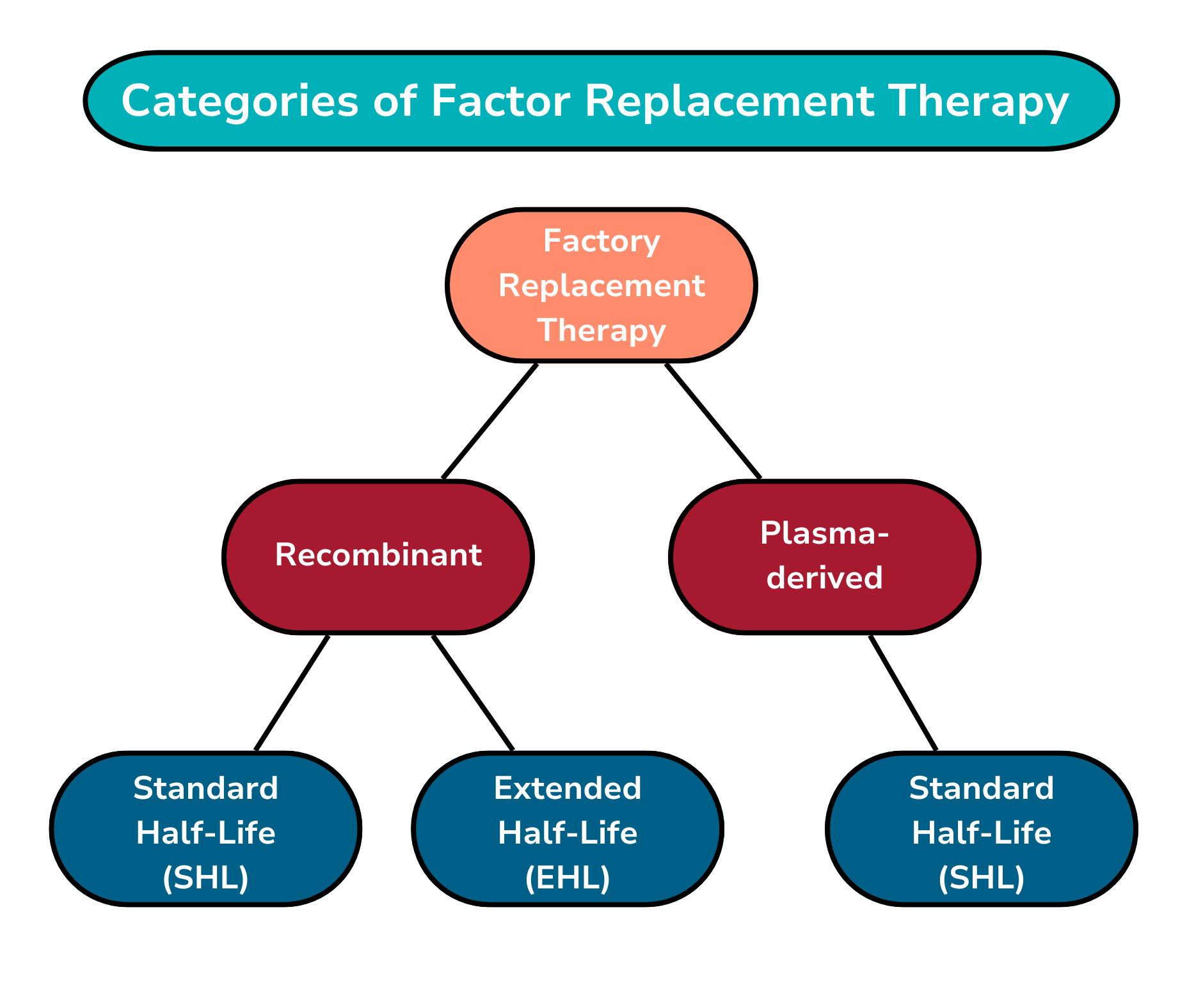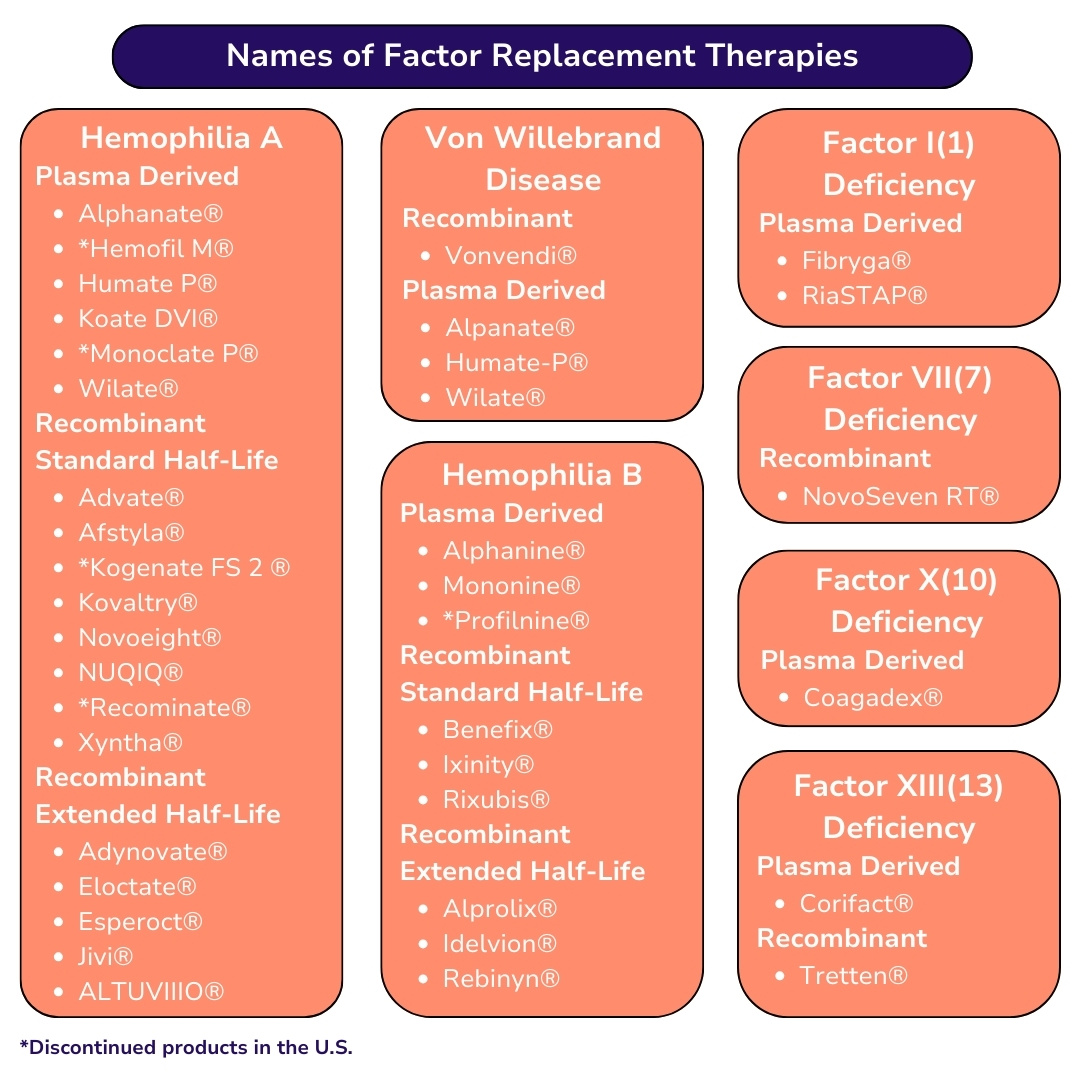As a parent or caregiver of tween or teen, making sure their bleeding disorder’s treatment is keeping up with their activities and growing independence is top of mind. You may have questions about the different types of treatment options for your child. This section has answers to common questions about factor replacement therapy. There are many factor replacement therapy products available. This section can help you develop your own set of questions to ask your child’s health care provider to find the best treatment option.
Clotting factor (called factor) is a dried powder form of the missing clotting factor. It is mixed with water to become a liquid before infusing it. Some clotting factor products, called plasma-derived factor, are made from donated human blood plasma. Others, called recombinant clotting factor, are made in a laboratory, and do not use human blood proteins.1
When clotting factor is given, the level of factor in the blood rises. This rise lasts only for a certain number of hours based on the clotting factor’s half-life. Half-life is the amount of time it takes the body to use up half of the factor circulating in the body. Factor replacement therapies can have a shorter or longer half-lives depending on:
- Which bleeding disorder your child has.
- How your child’s individual body uses up (metabolizes) the clotting factor.
- Whether your child is using standard half-life (SHL) therapy or extended half-life (EHL) therapy.
Below is more information about standard and extended half-life therapies.
- Standard half-life (SHL) therapies: SHL therapies are used to treat hemophilia A and B, some types of von Willebrand disease (VWD), and some rare factor deficiencies. The number of infusions a person may need can range from three times a week to every day, depending on the person.
Extended half-life (EHL) therapies: EHL therapies contain a molecule that has been altered so that there will be a delay in breaking down the clotting factor in the body. EHL therapies result in higher levels of clotting factor in the body, which last for a longer time, resulting in less frequent infusions. How long the factor is effective in the body depends on the person. EHL therapies are used to treat hemophilia A and B. For more information on EHLs, please visit the Role of Prolonged Half-Life Clotting Factors in Hemophilia.
If you would like to learn more about these topics go to the NBDF’s Educational Programs website.
If some time has passed since your child has treated and they still have pain, stiffness, or other signs of bleeding, they may need another dose of clotting factor. Sometimes another dose is recommended to be sure that a stable clot has formed, and the bleeding does not start again once the level of factor drops after treatment.2
Your health care provider can provide exact instructions on when to repeat treatment.
Below is a chart that shows the categories of factor replacement therapy.
Your child will receive factor replacement therapy using a needle placed into their vein so that medicine goes through the needle into the vein (called infusion). If you want more information about how to do infusions, please go to Infusion Basics. This process takes time; it isn't like getting a quick shot. Patients who are first diagnosed and need immediate treatment will initially be treated at the Hemophilia Treatment Center (HTC), the health care provider’s office, or the emergency department. Later, patients (or caregivers) will learn to infuse the factor at home (called home therapy). For more information about HTCs, please go to Hemophilia Treatment Centers.
Various devices (ports, catheters, or PICC lines) may be used to make it easier to get the factor into the bloodstream. Some of these devices are surgically inserted under the skin in the chest area. You and your child’s health care provider will decide which device is best for your child.
The amount of clotting factor depends on several other things, including:
- Weight - As weight increases, dosages will tend to get larger.
- The number of units in the bottle (called a vial) can vary depending on the product type.
Your child’s treatment team will help you learn how much clotting factor your child needs.
Clotting factor can be prescribed to take on a regular basis to prevent bleeds for some bleeding disorders, including hemophilia A and B, as well as VWD and some ultra-rare factor deficiencies. This usually depends on the bleeding disorder severity. Preventing bleeding ongoing is called “prophy” which is short for the fancy medical term prophylaxis (prevention). Clotting factor can be prescribed “on-demand” for preventing bleeding before a medical procedure. Clotting factor can also be prescribed “on demand” to treat a bleed once it has started, to stop bleeding as quickly as possible. These on-demand treatments are also called episodic care.
The amount of clotting factor needed to treat a bleed will vary based on some of the conditions below:
- The location of the bleeding site
- If it is a site of repeated bleeding (for example, if it is at a target joint)
- If the bleeding could cause damage to the brain or other vital organs
Sometimes another dose of clotting factor is needed several hours after taking the first dose to stop the bleeding. Your child’s treatment team will help you learn how much clotting factor your child needs and when to treat a potential bleeding episode.
Having factor available is important because you never know when a bleed might occur. Prompt treatment is critical. It is a good idea to work with your health care provider to see if you can have clotting factor with your child at all times, including when they are home, in the car, on vacation, and even when they go to the emergency room.2 Discuss what amount of clotting factor is enough to treat a major traumatic event, such as a head bleed. For more information about emergency room visits, please go to Emergency Room Visits.
Some of the benefits of using factor replacement therapy include the following:
- Replacing the missing factor needed for blood to clot.
- Safe – recombinant products are recommended by NHF’s Medical and Scientific Advisory Council (MASAC) and when not available, plasma derived products are recommended as they have greatly improved in safety and monitoring.
- Brings factor levels into normal range.
- Easy to measure factor levels with lab tests.
- Years of experience with surgery and treating bleeds.
- Both treats and prevents bleeds.
Some of the limitations with taking factor replacement therapy are as follows:
- Treatment is given often (many times a week typically)
- Must be given using an IV making it necessary to learn about ports and infusion. If you want to learn more about infusion, please visit Infusion Basics.
- The potential formation of cells in your child’s body that will attack the medication (called antibodies). This will cause the medication to be unable to work properly in your child’s body. This is also known as developing an inhibitor to the treatment. If you want more information about these antibodies, please go to Inhibitors.
- Factor levels don’t stay within normal range very long. They go up and down (peaks and troughs).
- If your child is taking an EHLs, they can be in the 2-4% factor level longer than when they are taking a SHLs. This could put them at risk for bleeds during that timeframe. Make sure to discuss this with your health care provider.
- Risk of blood borne diseases, such as hepatitis, from plasma derived products. This is because they contain human blood. Not all bleeding disorders have recombinant products available for treatment. Methods for screening blood and destroying blood-borne viruses have much improved. This makes medications created from blood products much safer to use. If you want more information about the safety of these products, please go to Blood Safety and Community Counts.
- There is one factor replacement therapy, NovoSeven RT®, that has a Box Warning from the FDA. This warning is used to draw attention to the serious or life-threatening side effects or risks. You can find the warning on the box or in the product insert. It is important to speak with your health care provider about this box warning and what it will mean if your child uses this treatment product.
- For information on all risks for each type and brand of factor replacement product, visit Products Licensed in the US | National Hemophilia Foundation
There are many different factor replacement treatments. Below are the brand names for the different products listed by bleeding disorder.
If you want more information about FDA-approved products for the treatment of bleeding disorders, please go to this list.
NHF’s Medical and Scientific Advisory Council. (2022). MASAC Recommendations Concerning Products Licensed for the Treatment of Hemophilia and Other Bleeding Disorders (MASAC 272). National Hemophilia Foundation. https://www.bleeding.org/healthcare-professionals/guidelines-on-care/masac-documents/masac-document-290-masac-recommendations-concerning-products-licensed-for-the-treatment-of-hemophilia-and-selected-disorders-of-the-coagulation-system
NHF’s Medical and Scientific Advisory Council. (2016). Recommendations Regarding Doses of Clotting Factor Concentrate in the Home (MASAC 242). National Hemophilia Foundation. https://www.hemophilia.org/healthcare-professionals/guidelines-on-care/masac-documents/masac-document-242-recommendations-regarding-doses-of-clotting-factor-concentrate-in-the-home


